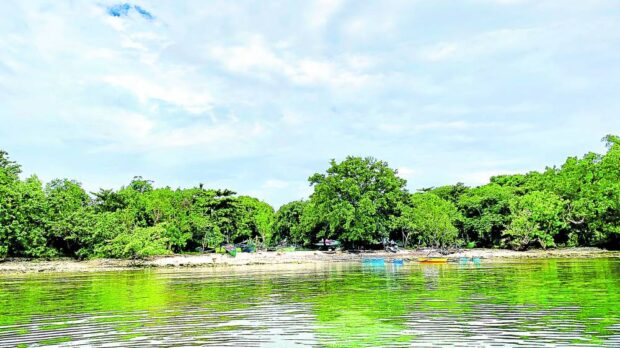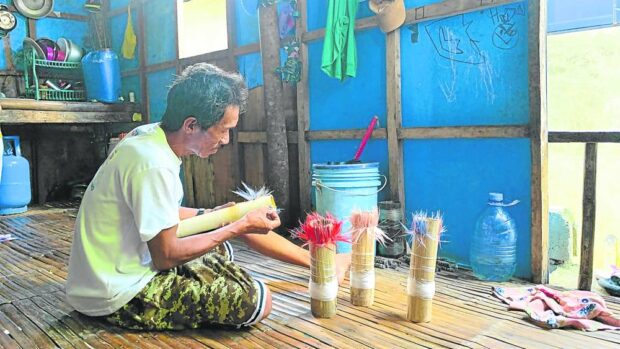Saving Oyon Bay

COMMUNITY EFFORT | Members of the San Salvador Biodiversity Friendly Association plant more mangroves on San Salvador Island in Masinloc, Zambales, in this photo taken on Aug. 18, 2023 (Photo by JOANNA ROSE AGLIBOT / Inquirer Central Luzon)
MASINLOC, Zambales, Philippines — Before catching the first glimpse of sunlight, Francisco Miranda, 54, groaned while staring at the vast ocean.
Miranda, a resident of Barangay South Poblacion here, scanned his surroundings and felt the chilly wind blow through his hair. At that very moment, he knew he could not leave for a fishing trip due to the inclement weather that prevails between July and December.
“It is difficult to venture out to the sea now because the waves are strong. When the weather is like this, you really have to be patient,” he told the Inquirer in an earlier interview. “If you have nothing saved, you need to borrow money. We have to work harder when the weather is good.”
Miranda is one of the registered municipal fisherfolk who continues to enjoy the bounty of Masinloc-Oyon Bay (or Oyon Bay) in Zambales province.
Considered one of the key biodiversity areas in the country, it is among the richest fishing grounds that thousands of fisherfolk in the towns of Masinloc and Palauig depend on for their livelihood.
Article continues after this advertisementThree decades ago, Masinloc-Oyon Bay was declared a Protected Seascape and Landscape (MOBPLS) under Republic Act No. 7586, or the National Integrated Protected Areas System Act, and became the first marine protected area in Central Luzon.
Article continues after this advertisementThe declaration was primarily to “protect and conserve the ecological, scenic, scientific and educational features of the area … to address the social and economic needs of the local communities without causing an adverse impact on the environment.”
But a recent study by the United States Agency for International Development (USAID), through its Sustainable Interventions for Biodiversity, Ocean and Landscapes (Sibol) project, showed that a relatively lower catch per unit effort of fishing gear in the MOBPLS indicates that the ecosystem has less fish to provide.
READ: UN says fish production rising, overfishing still a problem
READ: No more big fish; overfishing blamed
READ: PH losing coral reefs to gov’t neglect, overfishing—WWF
It also showed that fish are removed from the marine ecosystem without having contributed to replenishing their population so that there will be fish for the next generation to come.
For Miranda, there has been a noticeable drop in the volume of their catch because fisherfolk like him, who stopped fishing in the disputed Scarborough Shoal (locally known as Panatag Shoal, or Bajo de Masinloc), now rely heavily on Masinloc-Oyon Bay for their livelihood.

The island’s mangroves serve as a habitat not only for marine life in the surrounding Oyon Bay but also for different species of birds, other animals, and plants. (Photo by JOANNA ROSE AGLIBOT / Inquirer Central Luzon)
Diminishing catch
“Fewer fishermen are going to the Scarborough Shoal, just like me. Many are already here swarming this place,” shared Miranda.
Miranda remembered that he would earn enough in one trip to Panatag to support his family’s needs for a month. But since they were driven away by the China Coast Guard, they stopped going back, forcing them to stay in municipal waters.
“I will not return to Panatag because our situation there is difficult, apart from the distance, when there is a strong wave, our lives are at stake,” he lamented.
Scarborough Shoal is located some 250 kilometers from Masinloc town, well within the country’s 370-km exclusive economic zone. Thousands of fisherfolk in this province used to venture into the shoal, enduring a 14- to 18-hour trip, to reach this traditional fishing ground.
But in 2012, China, which has claimed nearly all of the West Philippine Sea, seized control of the shoal, prompting the Philippine government to bring the matter to the Permanent Court of Arbitration in The Hague, the Netherlands. In 2016, the arbitral tribunal invalidated China’s claims and classified the shoal as a traditional fishing ground that should be shared by neighboring countries.
China, however, continues to ignore the ruling.
Environmental stress
According to University of the Philippines professor and maritime expert Jay Batongbacal, the biodiversity of Masinloc-Oyon Bay is experiencing the usual environmental stress.
“But the biggest impact is always made by human activity — fishing, particularly, so if the fishing pressure is increased by the fact that fishermen are unable to fish elsewhere, definitely biodiversity will suffer,” Batongbacal said in a phone interview.
Until the late 1960s, residents of San Salvador island, which is about 2.5 km away from the mainland, recalled an abundance of coastal resources and a lack of resource use conflicts, which enabled fishers to enjoy open and unrestricted access to the bay.
But in the late 1980s, the effects of fishery depletion and unabated destruction of coral reefs began to be felt.
The average catch per unit effort reportedly dwindled from 20 kilograms per fishing trip in the 1960s to only about one to three kg in 1988.

REAPING THE FRUIT | Francisco Miranda, 54, and his fellow fishermen in Masinloc are now enjoying the bounty of Oyon Bay as a result of the protection of their community’s marine sanctuary. (Photo by JOANNA ROSE AGLIBOT / Inquirer Central Luzon)
Coal plant, dredging
Due to the decline of fish catch in the area, the nongovernmental organization Haribon Foundation, through its community-based resource management projects, helped establish the San Salvador Island Municipal Marine Reserve and Sanctuary under Presidential Proclamation No. 231, which has been maintained under a community management system.
During the 1990s, Haribon campaigned against projects that posed threats to the environment. One of these is the Masinloc coal-fired thermal plant, where campaign efforts led to the proclamation of Oyon Bay as a protected area.
According to Anna Varona, chief operating officer of Haribon, the purpose of having marine protected areas is to have a continuous cycle of fish production.
“A marine protected allows fish to have a safe place to reproduce and grow into the proper size. And when they grow into the proper size, they are forced to leave that area and that’s the time they should be caught by the fishermen,” she said.The plan to build the coal plant was delayed by four years because of the opposition, but it finally pushed through in 1998.
Aside from the coal plant, several fish cages and dredging activities still thrive in the area.
Leonado Cuaresma, president of the New Masinloc Fishermen Association, recalled that many fisherfolk were opposing the establishment of the marine protected area because it would mean the loss of their livelihood. Eventually, their acceptance increased when they noticed its benefits.
“Others think that the program was not effective before, but now everyone knows how important it is to preserve our natural resources,” observed Cuaresma.
Nature as provider
Maryjane Antonio, 49, recalled that when she was 10, her father would bring her to training and other activities to restore the island’s natural resources. Her father also served as a bantay-dagat (fish warden) in the 1980s.
Antonio believed that it was about time to continue what her father started.
“I am proud of what we do because we rely on what nature provides,” said Antonio, whose husband, Jesus Ginez, is also a fisherfolk.
Antonio and other members of the San Salvador Biodiversity Association have been helping to protect and plant more mangroves on the island.
The mangrove areas are the habitat of not only marine life but also different birds, flora, and fauna, said Thaddeus Martinez, chief forester from Haribon’s Natural Resources Management Division.
“So if we protect these different types of mangrove trees, we do really protect all of the natural resources,” noted Martinez.
One of the advocacies of Haribon is to engage the community “so they end up loving the land they live in and being protective about it,” said Varona.
“But when people are faced with an economic challenge, their decisions regarding the preservation and conservation of nature take second place. The first priority is what they will put on the table for their children to eat. How am I going to bring my children to school if I’m not making any money?” Varona added.
(Editor’s Note: This story has been produced through support from USAID Sibol, in partnership with AYEJ, under the Green Beat Plus biodiversity journalism training program. The content and publication of the report are the sole responsibility of the author and the publisher.)